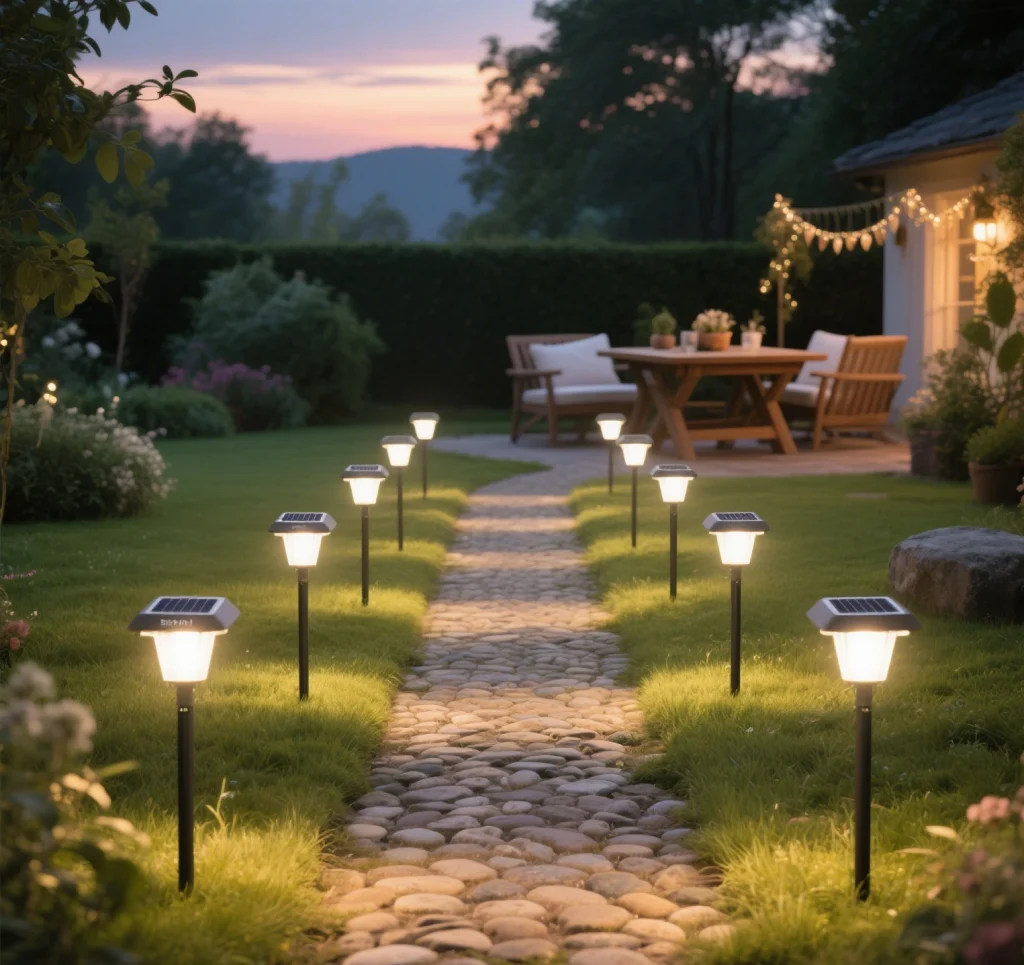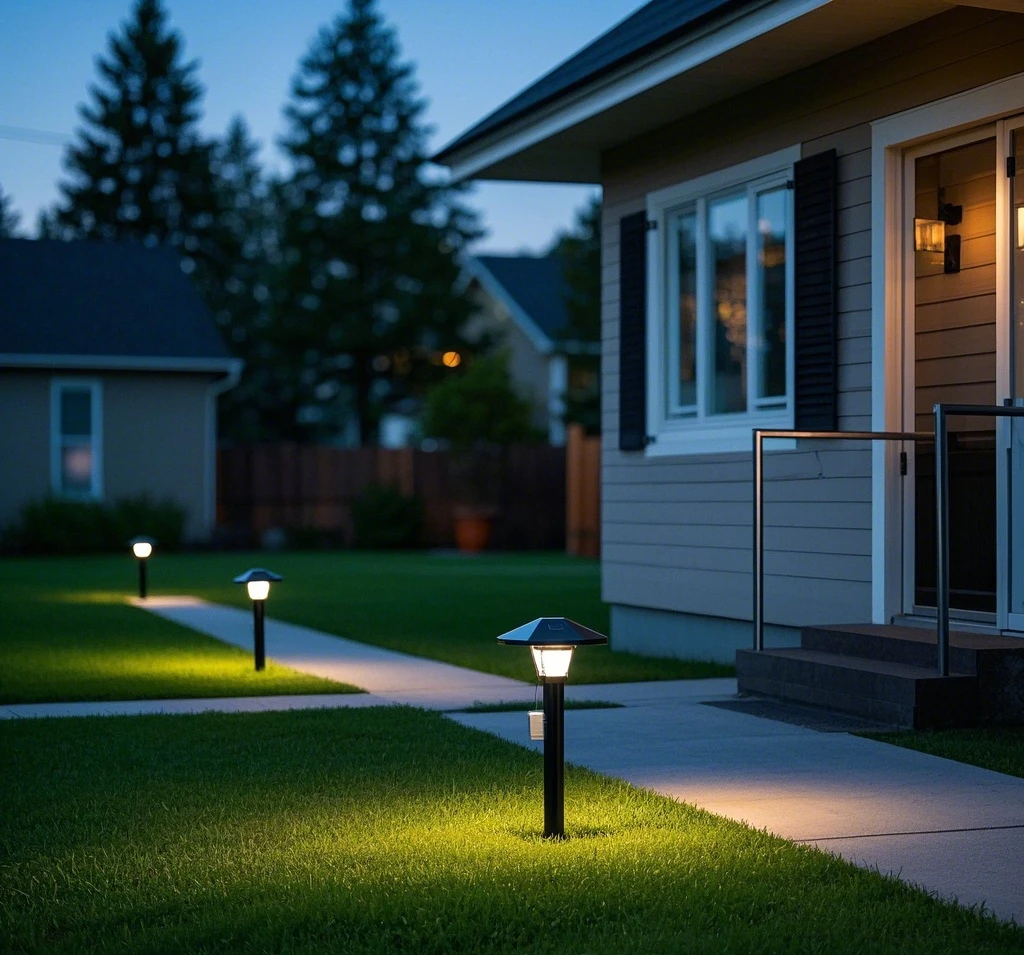Solar lights are a great way to light up your yard or driveway without adding to your energy bill. But when clouds roll in or winter shortens the days, you might wonder if these lights can still do their job. Spoiler: they can, but there are some limitations. This article explores how solar lighting operation functions during cloudy days and winter low sunlight, offering practical tips and guidance on choosing the right setup.

How Cloudy Days Affect Solar Panel Charging
Cloudy days reduce the amount of sunlight hitting your solar panels, which directly impacts their charging efficiency. On average, charging efficiency drop on cloudy days can range from 50-80% compared to clear, sunny conditions. Thin clouds might cut power output by about half, while heavy, dark clouds can slash it to just 10-20% of normal. Winter low sunlight compounds this with shorter days and weaker sun angles, potentially reducing charging by another 20-30%.
- Cloud thickness matters: Light clouds let through more sunlight than dense, stormy ones.
- Panel quality makes a difference: Higher-end panels capture more energy even in dim light.
- Location affects output: Regions with frequent overcast, like coastal areas, see bigger efficiency drops than sunnier climates.
While cloudy days limit charging, a good solar light can still function—it just might not charge fully, which brings us to the importance of battery storage.
Evaluating Battery Capacity for Enough Power
The battery is the heart of a solar light’s ability to shine through cloudy days or winter low sunlight. Battery capacity assessment helps you determine if a light can store enough energy to last through low-light periods. Most solar lights use lithium-ion or NiMH batteries, with capacities typically between 600mAh and 3000mAh. But how do you know if that’s enough for storage sufficiency?
Here’s a quick guide:
- Look at the specs: Check the battery’s mAh (milliamp-hour) rating. Higher mAh (e.g., 2000mAh or more) means more energy storage.
- Match to your needs: Estimate the light’s power draw. For example, a 1W LED might need about 1000mAh for an 8-hour night. Compare this to the battery’s capacity.
- Account for partial charging: On cloudy days, the battery might only get a partial charge, so a larger capacity can store extra energy from sunnier days.
A light with a 2000mAh battery, for instance, could last 2-3 nights even with minimal charging. Always dig into the product’s mAh rating—vague claims like “long-lasting” don’t cut it.

Do Solar Lights Last Multiple Days Without Sun?
Yes, multi-day endurance solar lights are designed to keep going through several days of low sunlight. These models pair high-capacity batteries (2000mAh or higher) with high-efficiency panels that make the most of weak light. They’re perfect for regions with frequent cloudy days or winter low sunlight.
What to look for:
- Battery size: Aim for 2000-3000mAh for 2-3 days of backup power.
- Energy-saving features: Some lights dim automatically or adjust brightness to conserve energy.
- Top-tier panels: Monocrystalline panels outperform polycrystalline ones in low-light conditions.
Brands like Philips, Ring, or Gama Sonic often offer lights with multi-day endurance. A high-quality solar floodlight, for example, might run for three nights on a single charge, though brightness could dip slightly by the end. These are a solid choice for consistent solar lighting operation in tough weather.
Practical Tips for Rainy Day Performance
You can’t change the weather, but you can optimize your solar lights to handle rainy days better. Here are some tips for rainy days to boost performance:
- Clean panels in advance: Dust or debris can block 5-20% of light. Wipe panels with a damp cloth before storms to maximize charging.
- Optimize placement: Angle panels toward the sun’s path (south-facing in the Northern Hemisphere) and avoid shade from trees or structures.
- Choose high-efficiency panels: Monocrystalline or PERC panels perform better in low light—check for efficiency ratings of 20% or higher.
- Store extra power: If you know cloudy days are coming, let the battery charge fully by turning off the light for a night or two.
- Use motion sensors: Lights with sensors use less power, saving energy for gloomier days.
These steps help, but don’t expect full performance. On heavily cloudy days, even great setups might only manage a few hours of light unless you’ve got a premium model.
Why Quality Solar Lights Perform Better in Rain
High-quality solar lights usable in rain are built to withstand tough conditions. Unlike cheap models, they come with weatherproofing (IP65 or higher), robust batteries, and efficient panels. Limited runtime is still an issue during prolonged cloudy periods, but quality lights handle it better.
Key features to look for:
- Weather resistance: Sealed designs protect batteries and circuits from water damage.
- Efficient LEDs: High-lumen LEDs (100+ lumens per watt) provide bright light with less power.
- Smart controllers: Some models adjust output based on weather, prioritizing energy storage.
For example, a premium solar path light might deliver 6-8 hours of light after a cloudy day, compared to 2-4 hours for a budget option. Investing in high efficiency and large capacity recommended products ensures better reliability.
Tackling Winter’s Low Sunlight
Winter low sunlight poses a unique challenge. With only 6-8 hours of daylight in some regions and weaker sun angles, panels might only capture 10-20% of their summer charging capacity. This is especially true in northern areas like Canada or Scandinavia.
How to manage:
- Prioritize high-efficiency panels: They’re essential for capturing weak, angled sunlight.
- Accept shorter runtimes: Limited runtime is normal—expect 4-6 hours instead of 10-12.
- Consider hybrid options: Some lights can switch to grid power or use a USB-charged battery for backup.
If winter is particularly dark where you live, hybrid lights might be worth the extra cost for consistent performance.
Picking the Best Solar Lights for Any Weather
To ensure your solar lights work year-round, focus on features that handle cloudy days and winter low sunlight. Here’s a checklist:
- Battery capacity: Choose 2000mAh or higher for multi-day endurance solar lights.
- Panel efficiency: Monocrystalline panels with 20%+ efficiency are ideal.
- Weatherproofing: Look for IP65 or better to withstand rain and snow.
- Smart features: Motion sensors or adaptive brightness save power.
- Reliability: Opt for brands with 1-2 year warranties and strong reviews for low-light performance.
Spending more on high-quality solar lights usable in rain pays off. Brands like BioLite or Goal Zero are known for durability and performance in challenging conditions.
Conclusion: Solar Lights Can Weather the Storm
Solar lights absolutely work on cloudy days and during winter low sunlight, but their performance depends on their quality. The charging efficiency drop on cloudy days means limited runtime, but high-quality solar lights usable in rain with large batteries and high-efficiency panels can shine for days. Using tips for rainy days like cleaning panels and smart placement helps maximize output. For the best results, high efficiency and large capacity recommended—choose multi-day endurance solar lights for cloudy or winter-heavy areas, and you’ll keep your space lit no matter the forecast.

Comments